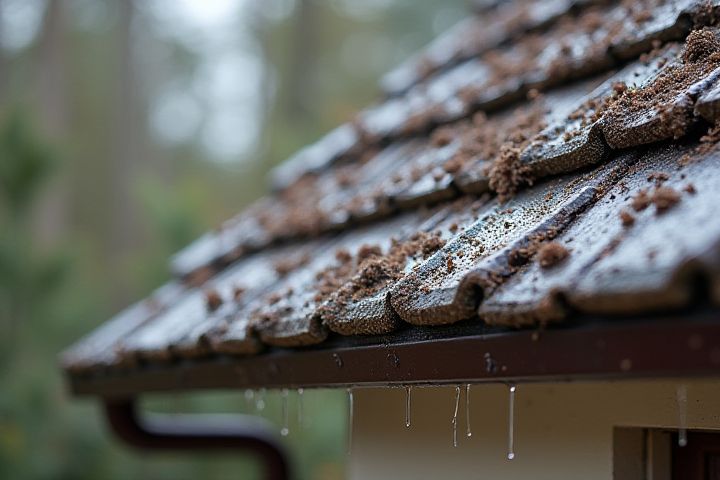
A leaking roof can stem from various issues including damaged shingles, poor installation, or aging materials. Cracked or missing shingles may allow water to penetrate, while improper flashing around chimneys and vents can lead to leaks during rain. Roof valleys that are not adequately designed may also contribute to water buildup, increasing the risk of leaks. Furthermore, clogged gutters can cause water to back up and seep under the roof's edge, creating potential damage. Regular maintenance and inspections can help identify these problems early, ensuring the longevity of your roof and protecting your home from further water damage.
Why Is The House Roof Leaking
Damaged or missing shingles
A leaking roof often stems from damaged or missing shingles, which compromise the barrier against water infiltration. Shingles can become brittle and break due to age, extreme weather conditions, or improper installation, leaving gaps that allow rain to seep into your home. Regular inspections of your roof can help identify wear and tear, enabling timely repairs before significant water damage occurs. If you notice water stains on ceilings or walls, examining your roof for compromised shingles should be your immediate priority.
Clogged gutters
A leaking roof often stems from clogged gutters, which can lead to a backup of water that overflows and seeps into your home. Accumulated debris, such as leaves and twigs, obstructs the flow of rainwater, causing it to pool around the roof edge and potentially damage shingles. Excess moisture from the stagnating water not only compromises the roof's structural integrity but can also create an environment for mold growth. Regularly cleaning your gutters ensures proper water drainage and prevents leaks, protecting your home's foundation and interior from water damage.
Poor roof installation
Poor roof installation can lead to significant leaks, often arising from improperly installed shingles, inadequate sealing, or misaligned flashing. These installation errors compromise the roof's integrity, allowing water to seep through vulnerable areas during rainstorms. Over time, even minor leaks can result in extensive water damage, mold growth, and decreased structural stability. Regular inspections, especially for homes over 10 years old, can help identify and rectify these issues before they escalate.
Cracked flashing
A leaky roof often stems from cracked flashing, which is the material used to direct water away from critical areas of the roof, such as chimneys and vents. When flashing deteriorates due to age, weather exposure, or improper installation, it can develop fissures that allow water to seep into underlying structures. This can result in insulation damage, mold growth, and costly repairs if not addressed promptly. Inspecting your roof for any visible signs of cracked flashing and replacing or repairing it can help prevent further water intrusion and preserve your home's integrity.
Ice dams
A leaking house roof may be a result of ice dams, which occur when snow on the roof melts and refreezes at the eaves, forming a solid barrier of ice. This trapped water can back up under the shingles, causing leaks into the attic or living spaces below. Factors contributing to ice dam formation include poor insulation and inadequate ventilation, leading to uneven roof temperatures. To prevent ice dams, ensure that your attic is well-insulated and that airflow is maintained to keep the roof cold during winter months.
Attic condensation
Attic condensation often occurs when warm, moist air rises from the living spaces and cools upon contact with the colder roof surface, leading to water droplets forming on beams and insulation. Inadequate ventilation in the attic exacerbates this issue, trapping moisture and creating an environment ripe for leaks. Insulation that is not properly installed can also contribute to insufficient airflow, ultimately allowing condensation to accumulate. Over time, persistent moisture from attic condensation can lead to mold growth and structural damage, making timely intervention essential for maintaining the integrity of your home.
Failed sealant around fixtures
A leaking roof often results from a failed sealant around fixtures, such as chimneys, vents, or skylights. Over time, exposure to harsh weather elements can cause the sealant to deteriorate, leading to gaps that allow water infiltration. If your roof features multiple fixtures, it's crucial to inspect each one regularly, as studies indicate that 90% of roof leaks originate from compromised areas around these components. Addressing and replacing failed sealant promptly can prevent costly water damage and extend the lifespan of your roof.
Aging roof materials
An aging roof can lead to leaks due to the deterioration of roofing materials over time, such as shingles or tiles losing their protective granules. Weather conditions, including intense sunlight and heavy rainfall, can exacerbate this wear, causing cracks and gaps that invite water infiltration. Regular inspections of an aging roof are crucial, as early detection of issues like curling, blistering, or missing shingles can prevent significant damage. Proper maintenance, including periodic cleaning and timely repairs, helps extend the life of your roof and safeguard your home from leaks.
Ventilation issues
A leaking house roof often stems from inadequate ventilation, which can trap moist air and lead to condensation. When warm air becomes stagnant in the attic, it causes moisture buildup that can damage roof components and promote mold growth. Optimal attic ventilation typically requires at least 1 square foot of vent space for every 300 square feet of attic space to maintain air circulation. You should regularly inspect your roof vents and insulation to ensure they are functioning effectively and to prevent water leaks.
Heavy rain or storm impact
A leaking house roof during heavy rain or storms is often attributed to several factors, such as worn-out shingles or damaged flashing. For instance, asphalt shingles typically last 15 to 30 years, but extreme weather conditions can accelerate their deterioration, leading to leaks. Furthermore, if the roof has not been properly inspected or maintained, underlying structural issues may allow water to infiltrate, resulting in significant damage over time. During storms, wind-driven rain can penetrate even the smallest cracks or gaps, highlighting the importance of regular roof maintenance to protect your home from costly repairs.
